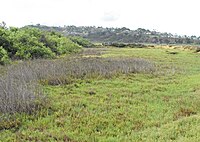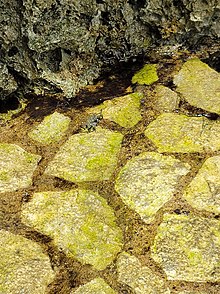Brackish marsh

Brackish marshes develop from
Characteristics
The salinity levels in brackish marshes can range from 0.5 ppt to 35 ppt.[2] Marshes are also characterised by low-growing vegetation and bare mud or sand flats.[3] Due to the variations in salinity, brackish marshes create a distinctive ecosystem where plants from either freshwater or saltwater marshes can co-inhabit.[4] The salinity levels also change with the tides, decreasing at low tide and increasing at high tide as ocean water feeds farther upriver.[5]
Ecosystem Services
- Reduces coastline erosion[6]
- Provides a coastal buffer from storms[6]
- Mitigates flooding[6]
- Filters and stores excess nitrogen from runoff water[6]
- Provides habitats for aquatic organisms
- Coastal wetlands sequester more carbon than any other environment[7][6]
Biodiversity
In terms of biodiversity, a brackish marsh serves a unique ecological niche.[8] Its vegetation is a byproduct of its salinity levels. High salinity serves as an evolutionary barrier for most plants, creating a less diverse number of plant species as an ecosystem moves from fresh to saltwater. Thus, there are only a few colonies of saltwater native plants in freshwater and almost no freshwater plants in saltwater ecosystems.[4] However, in brackish marshes both types of plants are prevalent and are in fact high in plant productivity.[4] Examples include, arrow arum (Peltandra virginica), soft rush (Juncus effusus), cattail (Typha), and sawgrass (Cladium).[2]
These plants are usually
These plant communities also create an environment that provides a nursery for juvenile fish, crustaceans,[12] and birds.[13] Fauna use the shallow habitat and the turbidity of the water to protect themselves from predators. Similarly the surface of the marsh is covered with vegetation which is used by the nekton species for shelter, leaving enough space to move underneath between the stems.[14]
The trophic levels within a brackish marsh has been shown to depend on the amount of macro organic matter in the upper level of soil. This macro organic matter is believed to be the food source of detritivore benthic animals that support higher trophic levels. These materials build up as the marsh matures, making age another factor in the biodiversity of a brackish marsh.[14]
as well as many others. Many organisms in these brackish marshes consume diatoms so they are very valuable to maintaining balance in these types of ecosystems.Another group of algae that is present in brackish marshes are fucoid algae.[20] This is a type of brown macroalgae in the class Phaeophyceae.[20] Brown algae are eukaryotic stramenopiles which means that they are at one point flagellated and most people know them as seaweeds in coastal areas.[21] Examples of brown algae that have been found in brackish marshes are Fucus vesiculosus , Ascophyllum nodosum, [20] the genus Sphacelaria, [22] and many others.

Yellow-green algae can also be found in brackish marshes. Yellow-green algae are eukaryotic algae in the class Xanthophyceae.[23] An example of this is Vaucheria. [22]
Green algae can also be found in brackish marshes. Some examples of the different genera of green algae that can be found in brackish marshes are Enteromorpha, Ulothrix, Rhizoclonium, Blidingia, Percursaria, and many others. [22]

Typically,
Human use and impacts
Brackish marshes are very important for
Brackish marsh environments are especially susceptible to human degradation; they are ideal areas for land conversion and development because they aren’t rocky and tend to be located in temperate coastal regions. Brackish marshes are areas that can provide connections for both land and water access.[6]
There are many ways humans have disrupted and degraded brackish marshes. When humans divert water from these marshes it leads to land sinking, also known as subsidence. Humans have also modified the vegetation of brackish marshes to change water and sediment flow. Brackish marshes have been subjected to an overabundance of nutrients and pollutants from industrial and urban sources. Environmental stressors from human impact have changed brackish marsh biodiversity to mainly stress-tolerant invasive grasses. Additionally, negative consequences of climate change, such as sea level rise, will likely begin to harm brackish marsh ecosystems.[6][7]
Brackish marshes can be restored by human intervention. Studies have found that given that
Conservation and threats
As in most habitats, the greatest threat towards brackish marshes are humans. Traditionally, direct human activities such as dredging and development are the main cause of destruction. Pollution has also been a threat to brackish marshes through chemical run-off.
For conservation, the key is to restrict human activities. Installing a passive management system could help restore certain species using brackish marshes' role as an ecological nursery.[27] For some areas, periodic livestock grazing could help create a better habitat for certain species of birds.[13] Brackish marshes are a unique type of wetland and the local circumstances are paramount to consider for either conservation, biodiversity, or restoration.
Brackish marshes are also great in reducing nutrient pollution such as nitrogen.[28] There are many sources of nitrogen entering the water systems especially in Texas. In Texas there are many dairy farms as well as ranch land and farm land. All these are sources of nitrogen in the Texas water systems. Having large amounts of nitrogen in a water system can cause eutrophication, harmful algal blooms, and fish kills.[28] In wetlands, nitrogen is used by the vascular and non-vascular vegetation to grow, therefore removing the nitrogen naturally and preventing a large amount of nitrogen from entering the coastal region creating anoxic habitats in the ocean.[28] Conservation of the brackish marsh wetlands can be a last resort to help prevent these potential problems.
References
- ^ Field Guide to Coastal Wetland Plants of the Southeastern United States, Ralph W. Tiner, p. 15
- ^ a b "Freshwater vs. Saltwater Wetlands in North Carolina" (PDF). Archived (PDF) from the original on 2021-04-17.
- ISSN 1552-8618.
- ^ S2CID 2199915.
- ^ a b "Brackish Tidal Marsh Guide - New York Natural Heritage Program". guides.nynhp.org. Retrieved 2021-04-17.
- ^ PMID 21141032.
- ^ PMID 24675669.
- ISSN 0025-326X.
- ISSN 0006-3207.
- ^ a b Schmalzer, Paul A. (1995-07-01). "Biodiversity of Saline and Brackish Marshes of the Indian River Lagoon: Historic and Current Patterns". Bulletin of Marine Science. 57 (1): 37–48.
- ^ PMID 27087929.
- ^ ISSN 0171-8630.
- ^ S2CID 83788168.
- ^ ISSN 1054-3139.
- ^ S2CID 33508939– via Wiley online library.
- S2CID 84822337.
- ISSN 0272-7714.
- ^ S2CID 53656496.
- ISSN 0007-1617.
- ^ S2CID 86377945.
- S2CID 9779828.
- ^ ISBN 978-94-010-8305-8, retrieved 2023-03-02
- ^ Gallagher, Susan B. (1981). "Vaucheria (Xanthophyceae, Vaucheriaceae) of the Central Florida Gulf Coast". Bulletin of Marine Science. 31 (1): 184–190 – via Ingenta.
- ^ a b Jenkins, Mackenzie L.; Schafer, Jennifer L. (2022). "Salt Marsh Plant Community Structure on Horse Island, South Carolina". Journal of the South Carolina Academy of Science. 20 (2): 9–12 – via Academic Search Complete.
- S2CID 245856791.
- S2CID 55198244.
- S2CID 220462500.
- ^ S2CID 229300707.




